oop实验三
实验任务一
源代码:

#include "window.hpp" #include <iostream> void test(){ Window w("Demo"); w.add_button("add"); w.add_button("remove"); w.add_button("modify"); w.add_button("add"); w.display(); w.close(); } int main() { std::cout << "用组合类模拟简单GUI:\n"; test(); }

#pragma once #include <iostream> #include <string> class Button { public: Button(const std::string &label_); const std::string& get_label() const; void click(); private: std::string label; }; Button::Button(const std::string &label_): label{label_} { } inline const std::string& Button::get_label() const { return label; } inline void Button::click() { std::cout << "Button '" << label << "' clicked\n"; }

#pragma once #include <iostream> #include <vector> #include <algorithm> #include "button.hpp" // 窗口类 class Window{ public: Window(const std::string &title_); void display() const; void close(); void add_button(const std::string &label); void click_button(const std::string &label); private: bool has_button(const std::string &label) const; private: std::string title; std::vector<Button> buttons; }; Window::Window(const std::string &title_): title{title_} { buttons.push_back(Button("close")); } inline void Window::display() const { std::string s(40, '*'); std::cout << s << std::endl; std::cout << "window : " << title << std::endl; int cnt = 0; for(const auto &button: buttons) std::cout << ++cnt << ". " << button.get_label() << std::endl; std::cout << s << std::endl; } inline void Window::close() { std::cout << "close window '" << title << "'" << std::endl; click_button("close"); } inline bool Window::has_button(const std::string &label) const { for(const auto &button: buttons) if(button.get_label() == label) return true; return false; } inline void Window::add_button(const std::string &label) { if(has_button(label)) std::cout << "button " << label << " already exists!\n"; else buttons.push_back(Button(label)); } inline void Window::click_button(const std::string &label) { for(auto &button:buttons) if(button.get_label() == label) { button.click(); return; } std::cout << "no button: " << label << std::endl; }
运行结果:
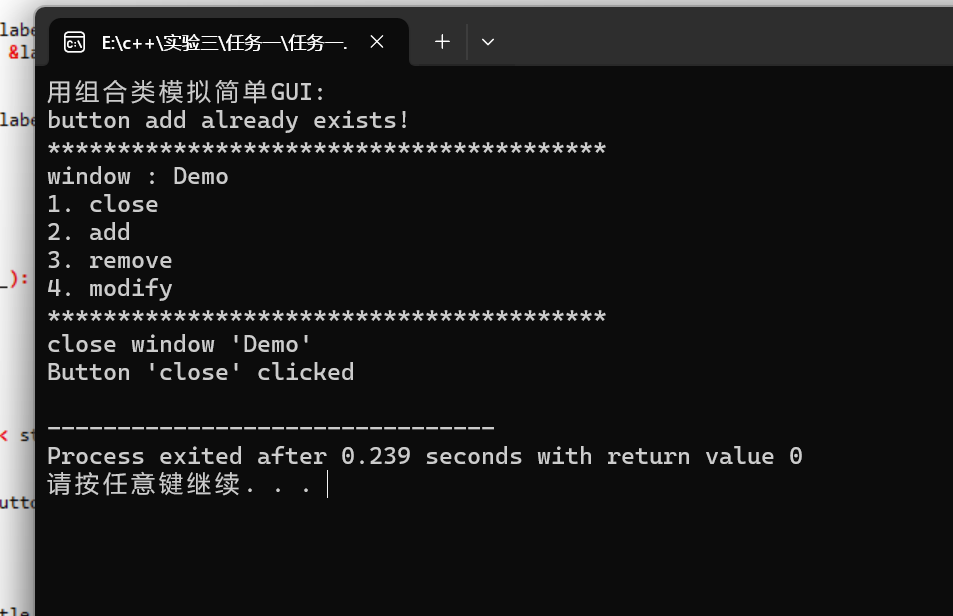
问题:
Q1:是的,我觉得是组合关系,因为window类有一个成员变量是std:vector<button>buttons,就是每个window对象都有button对象。窗口创建时按钮被创建,窗口关闭时它们被销毁,这样的类型就是组合关系。
Q2:
(1):优点是外面的人能直接调用这个函数来查询窗口有没有某个按钮 ,可能会更方便。缺点是暴露给外界后如果以后自己想修改has_button的实现方式会影响到别人使用,而且且也不符合封装性。
(2):如果是public,那就是给类的外部用户用的,函数的功能是用户完成任务需要的。如果是private,那就是给自己用的,用户对象不需要使用与知道。
Q3:接口一,返回的时label本身,没有副本,花费时间少速度快;安全性上,如果按钮被销毁了,那就用不了了。接口二,性能上就是把内部label字符串复制一份,这样如果字符串很长时复制就会浪费时间;安全性上,作为完整的副本很安全,就算按钮被销毁也能用。
Q4:能够正常运行。我的理解是push_back时构造一个临时对象然后把这个临时对象移动拷贝到vector末尾。而emplace_back是直接吧label这个参数传给vector。
实验任务二
源代码:

#include <iostream> #include <vector> void test1(); void test2(); void output1(const std::vector<int> &v); void output2(const std::vector<int> &v); void output3(const std::vector<std::vector<int>>& v); int main() { std::cout << "深复制验证1: 标准库vector<int>\n"; test1(); std::cout << "\n深复制验证2: 标准库vector<int>嵌套使用\n"; test2(); } void test1() { std::vector<int> v1(5, 42); const std::vector<int> v2(v1); std::cout << "**********拷贝构造后**********\n"; std::cout << "v1: "; output1(v1); std::cout << "v2: "; output1(v2); v1.at(0) = -1; std::cout << "**********修改v1[0]后**********\n"; std::cout << "v1: "; output1(v1); std::cout << "v2: "; output1(v2); } void test2() { std::vector<std::vector<int>> v1{{1, 2, 3}, {4, 5, 6, 7}}; const std::vector<std::vector<int>> v2(v1); std::cout << "**********拷贝构造后**********\n"; std::cout << "v1: "; output3(v1); std::cout << "v2: "; output3(v2); v1.at(0).push_back(-1); std::cout << "**********修改v1[0]后**********\n"; std::cout << "v1: \n"; output3(v1); std::cout << "v2: \n"; output3(v2); } // 使用xx.at()+循环输出vector<int>数据项 void output1(const std::vector<int> &v) { if(v.size() == 0) { std::cout << '\n'; return; } std::cout << v.at(0); for(auto i = 1; i < v.size(); ++i) std::cout << ", " << v.at(i); std::cout << '\n'; } // 使用迭代器+循环输出vector<int>数据项 void output2(const std::vector<int> &v) { if(v.size() == 0) { std::cout << '\n'; return; } auto it = v.begin(); std::cout << *it; for(it = v.begin()+1; it != v.end(); ++it) std::cout << ", " << *it; std::cout << '\n'; } // 使用auto for分行输出vector<vector<int>>数据项 void output3(const std::vector<std::vector<int>>& v) { if(v.size() == 0) { std::cout << '\n'; return; } for(auto &i: v) output2(i); }
运行结果:
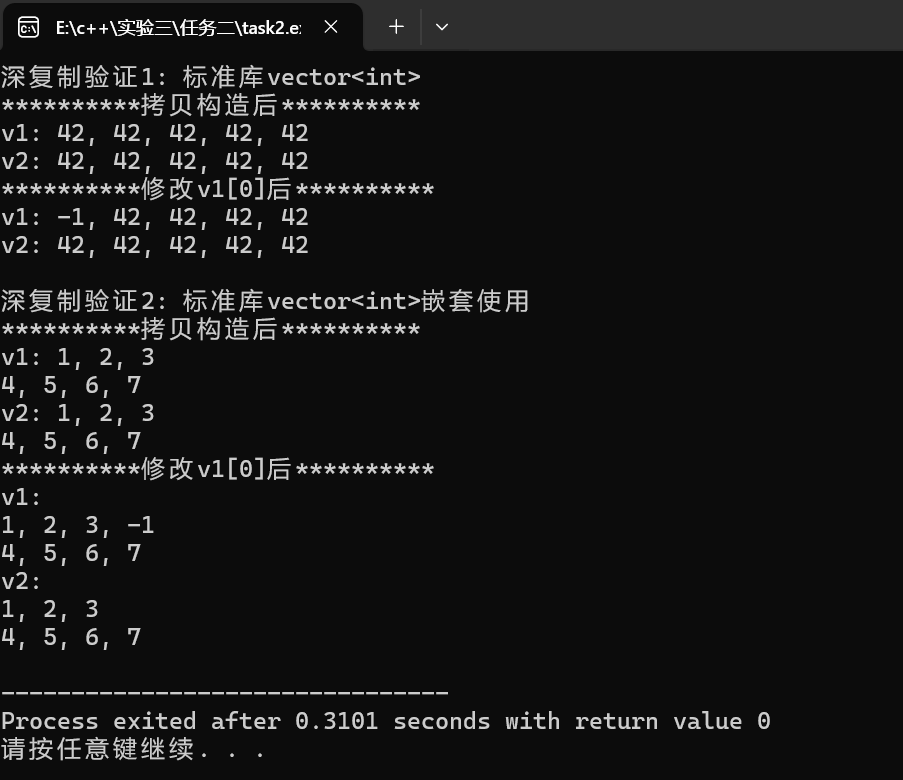
问题:
Q1:第一行代码是创建了一个叫v1的vector,里面有5个数字,每个数字都是42。第二行代码是用v1来创建一个新的vector叫v2,v2里面的内容和v1完全一样。v1和v2都包含5个值为42的数据项。
Q2:v1.size()是2,因为v1里面有2个小vector。v2.size()也是2,因为v2是v1的拷贝,所以也有2个小vector。v1[0].size也是3,因为v1的第一个小vector里面有3个数字分别是1,2,3。
Q3:可以效果都是v1的第一个数改成-1。区别是at(0)会检查0这个位置是否存在,如果不存在就会报错。而[0]不会检查,如果位置不存在可能程序崩溃。
Q4:
(1):可以输出-1,因为r是v1第一个小vector的引用,v1.at(0).push_back(-1)在第一个小vector的最后面加了一个-1,所以r.at(r.size()-1)就是取最后一个数,也就是-1。
(2):好处是节省内存,因为它不会把整个vector再复制一份,而是直接使用原来的vector。限制是不能通过这个const&来修改vector里面的内容。
Q5:
(1):从运行结果来看,修改v1不会影响v2,说明vector的复制构造函数做的是深复制。就是说v1和v2各有自己独立的内存空间。
(2):当v是普通的vector<int>时,v.at(0)返回的是int&,可以修改这个数。当v是const vector<int>时,v.at(0)返回的是const int&,只能读取不能修改。
at()必须提供const版本的重载,因为如果只有非const版本,那么在const对象上就用不了at()了。有了const版本,就既可以在普通vector上使用,也能在const vector上使用。
实验任务三
源代码:

#pragma once #include <iostream> // 动态int数组对象类 class vectorInt{ public: vectorInt(); vectorInt(int n_); vectorInt(int n_, int value); vectorInt(const vectorInt &vi); ~vectorInt(); int size() const; int& at(int index); const int& at(int index) const; vectorInt& assign(const vectorInt &vi); int* begin(); int* end(); const int* begin() const; const int* end() const; private: int n; // 当前数据项个数 int *ptr; // 数据区 }; vectorInt::vectorInt():n{0}, ptr{nullptr} { } vectorInt::vectorInt(int n_): n{n_}, ptr{new int[n]} { } vectorInt::vectorInt(int n_, int value): n{n_}, ptr{new int[n_]} { for(auto i = 0; i < n; ++i) ptr[i] = value; } vectorInt::vectorInt(const vectorInt &vi): n{vi.n}, ptr{new int[n]} { for(auto i = 0; i < n; ++i) ptr[i] = vi.ptr[i]; } vectorInt::~vectorInt() { delete [] ptr; } int vectorInt::size() const { return n; } const int& vectorInt::at(int index) const { if(index < 0 || index >= n) { std::cerr << "IndexError: index out of range\n"; std::exit(1); } return ptr[index]; } int& vectorInt::at(int index) { if(index < 0 || index >= n) { std::cerr << "IndexError: index out of range\n"; std::exit(1); } return ptr[index]; } vectorInt& vectorInt::assign(const vectorInt &vi) { if(this == &vi) return *this; int *ptr_tmp; ptr_tmp = new int[vi.n]; for(int i = 0; i < vi.n; ++i) ptr_tmp[i] = vi.ptr[i]; delete[] ptr; n = vi.n; ptr = ptr_tmp; return *this; } int* vectorInt::begin() { return ptr; } int* vectorInt::end() { return ptr+n; } const int* vectorInt::begin() const { return ptr; } const int* vectorInt::end() const { return ptr+n; }

#include "vectorInt.hpp" #include <iostream> void test1(); void test2(); void output1(const vectorInt &vi); void output2(const vectorInt &vi); int main() { std::cout << "测试1: \n"; test1(); std::cout << "\n测试2: \n"; test2(); } void test1() { int n; std::cout << "Enter n: "; std::cin >> n; vectorInt x1(n); for(auto i = 0; i < n; ++i) x1.at(i) = (i+1)*10; std::cout << "x1: "; output1(x1); vectorInt x2(n, 42); vectorInt x3(x2); x2.at(0) = -1; std::cout << "x2: "; output1(x2); std::cout << "x3: "; output1(x3); } void test2() { const vectorInt x(5, 42); vectorInt y; y.assign(x); std::cout << "x: "; output2(x); std::cout << "y: "; output2(y); } // 使用xx.at()+循环输出vectorInt对象数据项 void output1(const vectorInt &vi) { if(vi.size() == 0) { std::cout << '\n'; return; } std::cout << vi.at(0); for(auto i = 1; i < vi.size(); ++i) std::cout << ", " << vi.at(i); std::cout << '\n'; } // 使用迭代器+循环输出vectorInt对象数据项 void output2(const vectorInt &vi) { if(vi.size() == 0) { std::cout << '\n'; return; } auto it = vi.begin(); std::cout << *it; for(it = vi.begin()+1; it != vi.end(); ++it) std::cout << ", " << *it; std::cout << '\n'; }
运行结果:
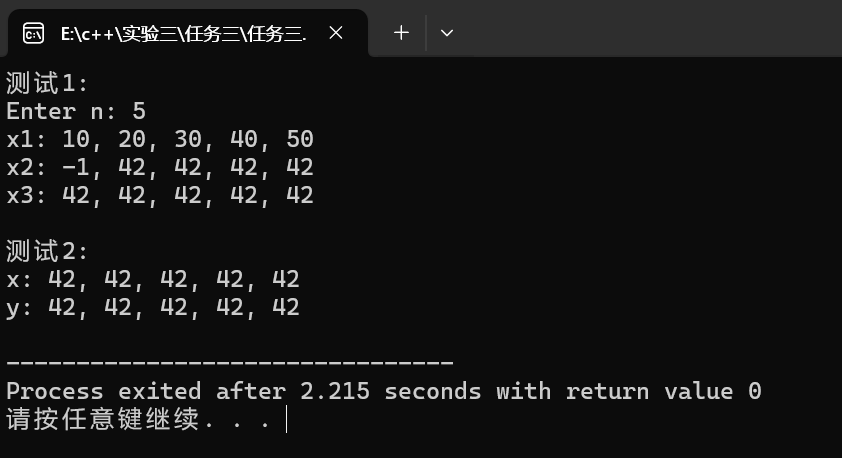
问题:
Q1:版本2x.assign(x),这样会先把自己的ptr删掉,然后又去用已经被删掉的ptr来复制数据,程序会崩溃。而原版本是准备好新的数据,没问题后再删除旧的,这样更稳妥。
Q2:
(1):这句话的作用是转换指针类型。转换前this是普通的vectorInt指针,转换后变成了const vectorInt指针。目的是
(2):这句话的作用是把不能修改的引用转化为可以修改的引用。转化前从const版本at得到的是const int&(不能修改的引用),转化后变成int&(可以修改的引用)。目的是由于最终要返回的是可以修改的引用,所以要把const去掉。
Q3:v.begin是调用非const版本,因为v1是普通对象。v2.begin是调用const版本,因为v2是const对象。非const版本是当你想修改vector里面的数据时用这个,const版本是当你只想读取数据不想修改时用这个。
Q4:第一行代码是把value这个值复制n份,从ptr开始的位置连续放好。这样代替了原来要写一个for循环来逐个赋值。第二行代码是类似于整段复制,把vi.ptr开始的vi.n个数据,整个复制到ptr那里,代替了原来要写循环一个一个元素的拷贝。第三行代码也是整段复制,把从vi.ptr开始的vi.n个数据整个复制到ptr_tmp那里。
实验任务四
源代码:

#include "matrix.hpp" #include <iostream> #include <cstdlib> Matrix::Matrix(int rows_, int cols_, double value) { n_rows = rows_; n_cols = cols_; if (rows_ <= 0 || cols_ <= 0) { std::cout << "Error: Invalid matrix dimensions" << std::endl; exit(1); } ptr = new double[n_rows * n_cols]; for (int i = 0; i < n_rows * n_cols; i++) { ptr[i] = value; } } Matrix::Matrix(int rows_, double value) { n_rows = rows_; n_cols = rows_; if (rows_ <= 0) { std::cout << "Error: Invalid matrix dimension" << std::endl; exit(1); } ptr = new double[n_rows * n_cols]; for (int i = 0; i < n_rows * n_cols; i++) { ptr[i] = value; } } Matrix::Matrix(const Matrix &x) { n_rows = x.n_rows; n_cols = x.n_cols; ptr = new double[n_rows * n_cols]; for (int i = 0; i < n_rows * n_cols; i++) { ptr[i] = x.ptr[i]; } } Matrix::~Matrix() { delete[] ptr; } void Matrix::set(const double *pvalue, int size) { if (size != n_rows * n_cols) { std::cout << "Error: Size mismatch in set function" << std::endl; exit(1); } for (int i = 0; i < size; i++) { ptr[i] = pvalue[i]; } } void Matrix::clear() { for (int i = 0; i < n_rows * n_cols; i++) { ptr[i] = 0; } } const double& Matrix::at(int i, int j) const { if (i < 0 || i >= n_rows) { std::cout << "Error: Row index out of bounds" << std::endl; exit(1); } if (j < 0 || j >= n_cols) { std::cout << "Error: Column index out of bounds" << std::endl; exit(1); } return ptr[i * n_cols + j]; } double& Matrix::at(int i, int j) { if (i < 0 || i >= n_rows) { std::cout << "Error: Row index out of bounds" << std::endl; exit(1); } if (j < 0 || j >= n_cols) { std::cout << "Error: Column index out of bounds" << std::endl; exit(1); } return ptr[i * n_cols + j]; } int Matrix::rows() const { return n_rows; } int Matrix::cols() const { return n_cols; } void Matrix::print() const { for (int i = 0; i < n_rows; i++) { std::cout << " " << at(i, 0); for (int j = 1; j < n_cols; j++) { std::cout << ", " << at(i, j); } std::cout << std::endl; } }

#pragma once #include <iostream> #include <algorithm> #include <cstdlib> // 类Matrix声明 class Matrix { public: Matrix(int rows_, int cols_, double value = 0); // 构造rows_*cols_矩阵对象, 初值value Matrix(int rows_, double value = 0); // 构造rows_*rows_方阵对象, 初值value Matrix(const Matrix &x); // 深复制 ~Matrix(); void set(const double *pvalue, int size); // 按行复制pvalue指向的数据,要求size=rows*cols,否则报错退出 void clear(); // 矩阵对象数据项置0 const double& at(int i, int j) const; // 返回矩阵对象索引(i,j)对应的数据项const引用(越界则报错后退出) double& at(int i, int j); // 返回矩阵对象索引(i,j)对应的数据项引用(越界则报错后退出) int rows() const; // 返回矩阵对象行数 int cols() const; // 返回矩阵对象列数 void print() const; // 按行打印数据 private: int n_rows; // 矩阵对象内元素行数 int n_cols; // 矩阵对象内元素列数 double *ptr; // 数据区 };

#include <iostream> #include <cstdlib> #include "matrix.hpp" void test1(); void test2(); void output(const Matrix &m, int row_index); int main() { std::cout << "测试1: \n"; test1(); std::cout << "\n测试2: \n"; test2(); } void test1() { double x[1000] = {1, 2, 3, 4, 5, 6, 7, 8, 9, 10}; int n, m; std::cout << "Enter n and m: "; std::cin >> n >> m; Matrix m1(n, m); // 创建矩阵对象m1, 大小n×m m1.set(x, n*m); // 用一维数组x的值按行为矩阵m1赋值 Matrix m2(m, n); // 创建矩阵对象m2, 大小m×n m2.set(x, m*n); // 用一维数组x的值按行为矩阵m1赋值 Matrix m3(n); // 创建一个n×n方阵对象 m3.set(x, n*n); // 用一维数组x的值按行为矩阵m3赋值 std::cout << "矩阵对象m1: \n"; m1.print(); std::cout << "矩阵对象m2: \n"; m2.print(); std::cout << "矩阵对象m3: \n"; m3.print(); } void test2() { Matrix m1(2, 3, -1); const Matrix m2(m1); std::cout << "矩阵对象m1: \n"; m1.print(); std::cout << "矩阵对象m2: \n"; m2.print(); m1.clear(); m1.at(0, 0) = 1; std::cout << "m1更新后: \n"; std::cout << "矩阵对象m1第0行 "; output(m1, 0); std::cout << "矩阵对象m2第0行: "; output(m2, 0); } // 输出矩阵对象row_index行所有元素 void output(const Matrix &m, int row_index) { if(row_index < 0 || row_index >= m.rows()) { std::cerr << "IndexError: row index out of range\n"; exit(1); } std::cout << m.at(row_index, 0); for(int j = 1; j < m.cols(); ++j) std::cout << ", " << m.at(row_index, j); std::cout << '\n'; }
运行结果:
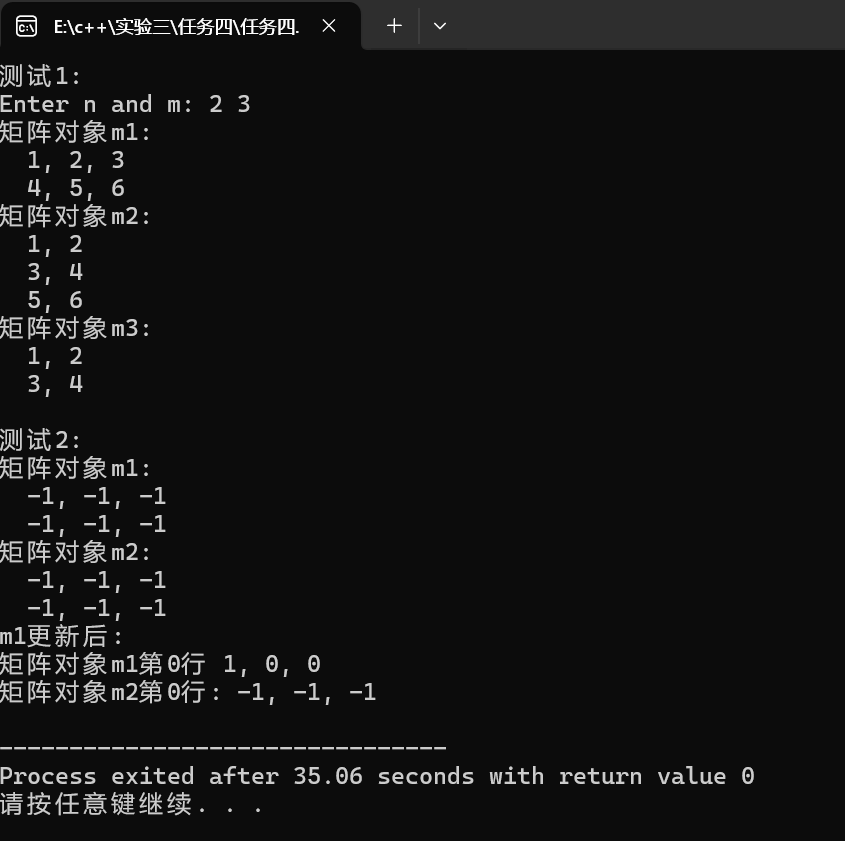
实验任务五:
源代码:

#include "contactBook.hpp" void test() { ContactBook contactbook; std::cout << "1. add contacts\n"; contactbook.add("Bob", "18199357253"); contactbook.add("Alice", "17300886371"); contactbook.add("Linda", "18184538072"); contactbook.add("Alice", "17300886371"); std::cout << "\n2. display contacts\n"; std::cout << "There are " << contactbook.size() << " contacts.\n"; contactbook.display(); std::cout << "\n3. find contacts\n"; contactbook.find("Bob"); contactbook.find("David"); std::cout << "\n4. remove contact\n"; contactbook.remove("Bob"); contactbook.remove("David"); } int main() { test(); }

#pragma once #include <iostream> #include <string> // 联系人类 class Contact { public: Contact(const std::string &name_, const std::string &phone_); const std::string &get_name() const; const std::string &get_phone() const; void display() const; private: std::string name; // 必填项 std::string phone; // 必填项 }; Contact::Contact(const std::string &name_, const std::string &phone_):name{name_}, phone{phone_} { } const std::string& Contact::get_name() const { return name; } const std::string& Contact::get_phone() const { return phone; } void Contact::display() const { std::cout << name << ", " << phone; }

# pragma once #include <iostream> #include <string> #include <vector> #include <algorithm> #include "contact.hpp" // 通讯录类 class ContactBook { public: void add(const std::string &name, const std::string &phone); // 添加联系人 void remove(const std::string &name); // 移除联系人 void find(const std::string &name) const; // 查找联系人 void display() const; // 显示所有联系人 size_t size() const; private: int index(const std::string &name) const; // 返回联系人在contacts内索引,如不存在,返回-1 void sort(); // 按姓名字典序升序排序通讯录 private: std::vector<Contact> contacts; }; void ContactBook::add(const std::string &name, const std::string &phone) { if(index(name) == -1) { contacts.push_back(Contact(name, phone)); std::cout << name << " add successfully.\n"; sort(); return; } std::cout << name << " already exists. fail to add!\n"; } void ContactBook::remove(const std::string &name) { int i = index(name); if(i == -1) { std::cout << name << " not found, fail to remove!\n"; return; } contacts.erase(contacts.begin()+i); std::cout << name << " remove successfully.\n"; } void ContactBook::find(const std::string &name) const { int i = index(name); if(i == -1) { std::cout << name << " not found!\n"; return; } contacts[i].display(); std::cout << '\n'; } void ContactBook::display() const { for(auto &c: contacts) { c.display(); std::cout << '\n'; } } size_t ContactBook::size() const { return contacts.size(); } // 待补足1:int index(const std::string &name) const;实现 // 返回联系人在contacts内索引; 如不存在,返回-1 int ContactBook::index(const std::string &name) const { for (int i = 0; i < contacts.size(); i++) { if (contacts[i].get_name() == name) { return i; } } return -1; } // 待补足2:void ContactBook::sort();实现 // 按姓名字典序升序排序通讯录 void ContactBook::sort() { int n = contacts.size(); for (int i = 0; i < n - 1; i++) { for (int j = 0; j < n - i - 1; j++) { if (contacts[j].get_name() > contacts[j + 1].get_name()) { Contact temp = contacts[j]; contacts[j] = contacts[j + 1]; contacts[j + 1] = temp; } } } }
运行结果:
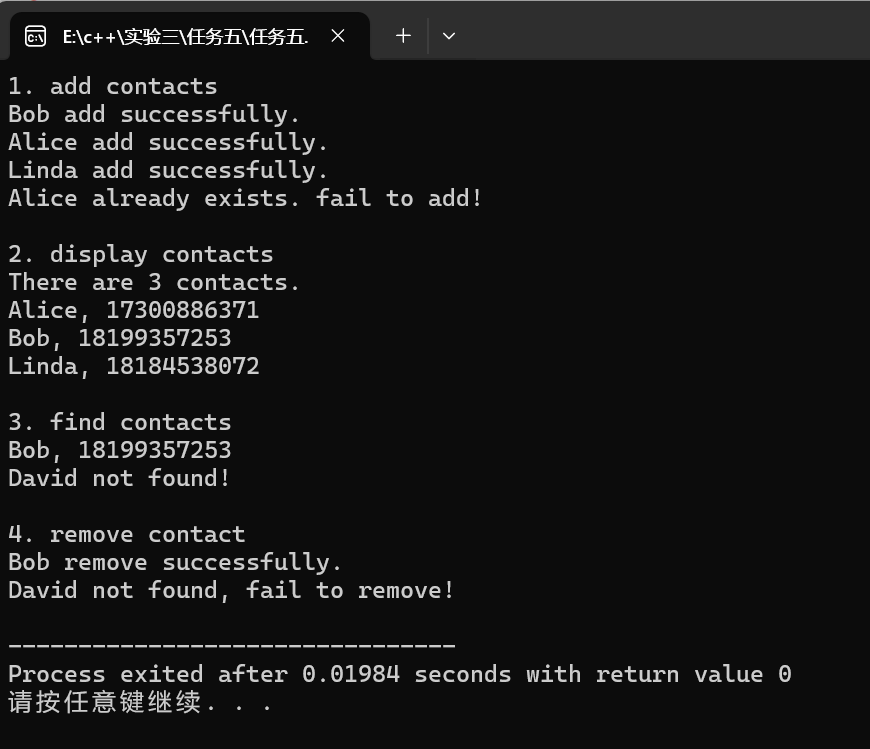






 浙公网安备 33010602011771号
浙公网安备 33010602011771号